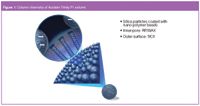Simultaneous Separation of Pharmaceutical Counterions on a Reversed-Phase/Anion-Exchange/Cation-Exchange Tri-Mode HPLC Column
The Application Notebook
Salt formation is a critical aspect in drug development and HPLC is an important tool for determination of pharmaceutical counterions.
Xiaodong Liu and Christopher Pohl, Dionex Corporation, Sunnyvale, California, USA.
Salt formation is a critical aspect in drug development1 and HPLC is an important tool for determination of pharmaceutical counterions. Reversed-phase columns often fail to retain very hydrophilic counterions. Ion chromatography (IC) is preferred for selective and sensitive screening of cationic and anionic pharmaceutical counterions,2 usually with multiple runs. Positive and negative counterions can be separated simultaneously using a zwitterionic HILIC column using an evaporative light-scattering detector.3 However, the zwitterionic column method has limitations: (1) limited to HILIC mode; (2) ions are retained as salts rather than via ion-exchange, making method development difficult; and (3) the method is not suitable for simultaneous separation of acidic, basic and neutral analytes.
Recently, Dionex developed a new silica HPLC column, the Acclaim Trinity P1, for the simultaneous separation of active pharmaceutical ingredients (API) and their counterions. This column is based on the innovative Nanopolymer Silica Hybrid (NSH) technology: the silica inner-core contains pores layered with organic material that provides reversed-phase and anion exchange properties and the outer surface area is modified with cation-exchange functionality (Figure 1). The NSH technology ensures distinctive spatial separation of the exchange sites so that all retention mechanisms (RP, AEX and CEX) can function simultaneously and can be controlled independently.

Figure 1
Experimental
An Acclaim Trinity P1 column (3.0 × 50 mm, dp = 3 µm, Dionex) was used for the separation on a modular UltiMate 3000 HPLC System (Dionex) equipped with an LPG 3600 gradient pump, WPS-3000 Autosampler, TCC-3200 column oven and a Sedex-85 evaporative light-scattering detector (Sedere, Alfortville, France). The Chromeleon 6.70 chromatography management software (Dionex) was used for system control and data processing. All standards were purchased from Sigma-Aldrich (St Louis, Missouri, USA).
Results and Discussion
The column provides optimal selectivity for separating common cationic and anionic pharmaceutical counterions in an acetonitrile/ammonium acetate mobile phase system. Figure 2 demonstrates that a 50 mm long column baseline resolves six cations isocratically in the first 3 min and then an increasing buffer concentration elutes 10 anions according to their actual charges under the test conditions. The column selectivity is designed such that cations elute before anions, or elute in separate time frames. This is the first example in which cations and anions can be separated in such a simple and reliable way. This method is a starting point for users to develop their own methods and depending on application requirements, the buffer concentration, pH and/or gradient can be adjusted to optimize the separation.
Figure 2
Conclusion
The Acclaim Trinity P1 column is a high-efficiency silica column that provides concurrent reversed-phase, anion-exchange and cation-exchange properties resulting in optimal selectivity and maximum flexibility in method development. Key applications include pharmaceutical counterions (anions and cations), drug substances and counterions and mixtures of basic and acidic drugs with their counterions.
References
1. Y. Kazakevich and R. Lobrutto, HPLC for Pharmaceutical Scientists, Wiley-Interscience, New Jersey, USA (2007).
2. Dionex website: www.dionex.com/en-us/webdocs/4642_an106.pdf
4. Dionex website: http://www.dionex.com/en-us/columns-accessories/specialty/cons70695.html
Acclaim, UltiMate and Chromeleon are registered trademarks of Dionex Corporation.

Dionex Corporation
1228 Titan Way, PO Box 3603, Sunnyvale
California 94088-3603, USA
tel. +1 408 737 0700 fax +1 408 730 9403
Website: www.dionex.com

Removing Double-Stranded RNA Impurities Using Chromatography
April 8th 2025Researchers from Agency for Science, Technology and Research in Singapore recently published a review article exploring how chromatography can be used to remove double-stranded RNA impurities during mRNA therapeutics production.
Troubleshooting Everywhere! An Assortment of Topics from Pittcon 2025
April 5th 2025In this installment of “LC Troubleshooting,” Dwight Stoll touches on highlights from Pittcon 2025 talks, as well as troubleshooting advice distilled from a lifetime of work in separation science by LCGC Award winner Christopher Pohl.


















